4 Basic Transaction Entry
After logging in at the Home screen (See Login), the Start Sale option in the Home Screen Menu provides you with the ability to perform sale transactions.
This chapter covers the following functions:
Start Transaction
To start a sale transaction:
Select Start Sale from the Home Screen to start a new transaction.
Entering Pre-Sale Information
Depending on your store configuration, pre-sale screens that display after login may include:
Selecting Commissioned Associates
If your store tracks the associates' sales for commissions and sales goals, you may be prompted to select a commissioned associate (or associates) to be linked to the items in a sale transaction. There are two ways to select a commissioned associate for a transaction:
-
Select the sale associate(s) for this transaction from the list by touching the name and select OK.
-
Alternatively, select the Select By ID option.
For each associate to add to the transaction:
-
Enter Associate ID. The ID of the logged-in user is the default value.
-
Select OK.
-
When you are finished adding associates, leave the associate ID field blank.
-
Select OK.
-
Continue the transaction with:
<OR>
Customer Panel
The Customer Panel displays information about the customer including loyalty, offers, and item messages. The panel also displays the Quick Items button.
Selecting anywhere on the panel displays the Customer Overview drawer.
Figure 4-1 Customer Panel - Desktop
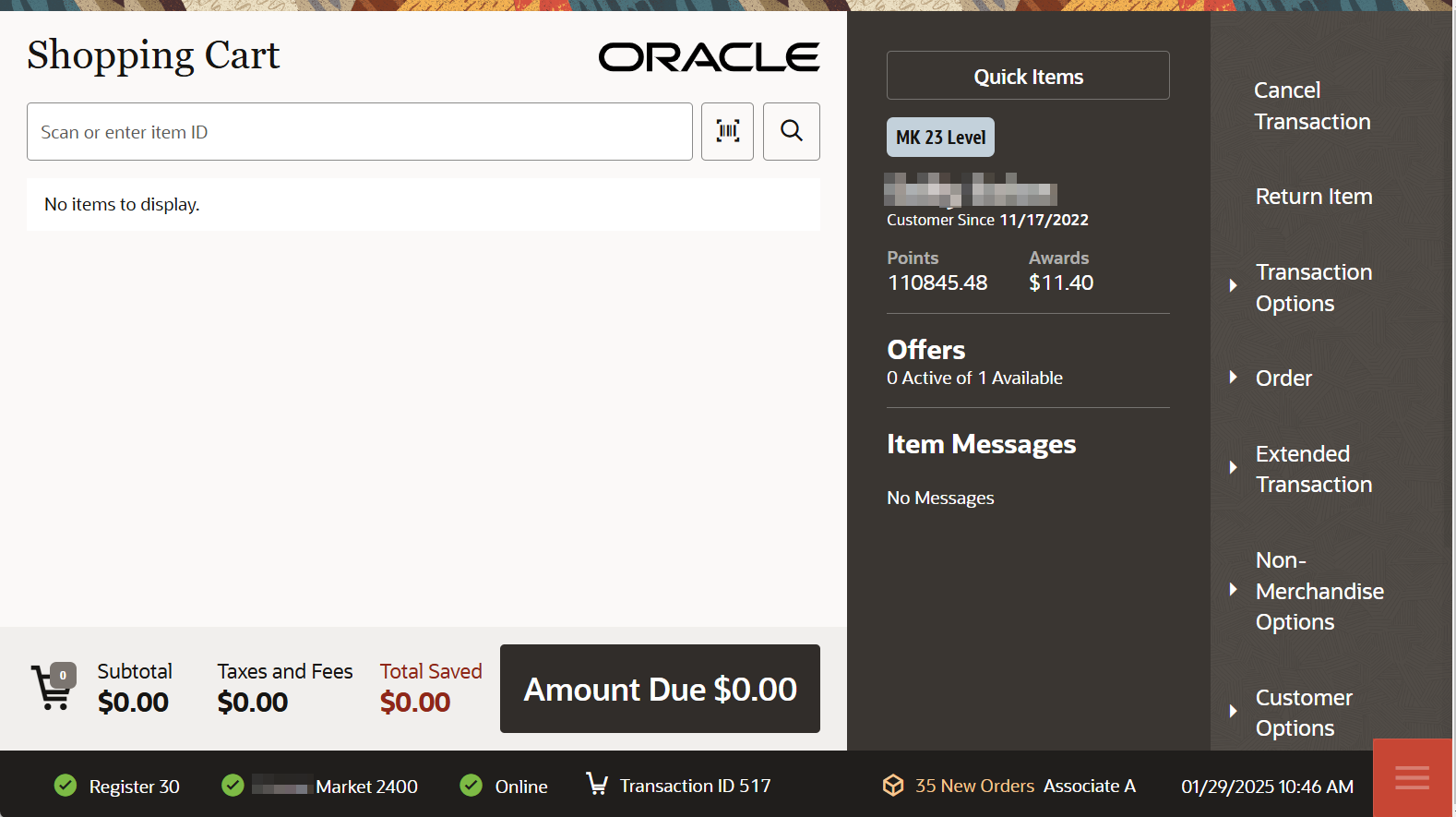
Figure 4-2 Customer Panel - Tablet
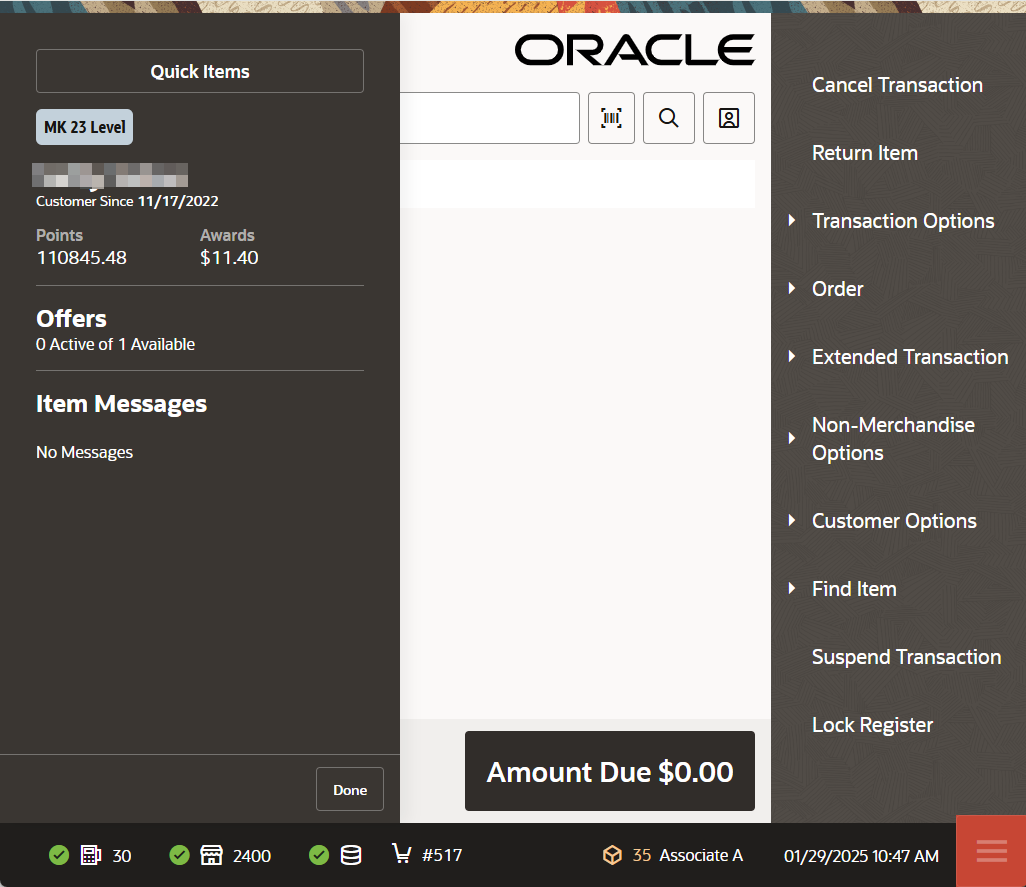
Note:
If the customer is not linked to the transaction, a plus sign and message to Add customer is displayed. Select the Plus Sign to add the customer.Figure 4-3 Customer Panel - Handheld

Figure 4-4 Customer Panel (Customer Attached) - Handheld
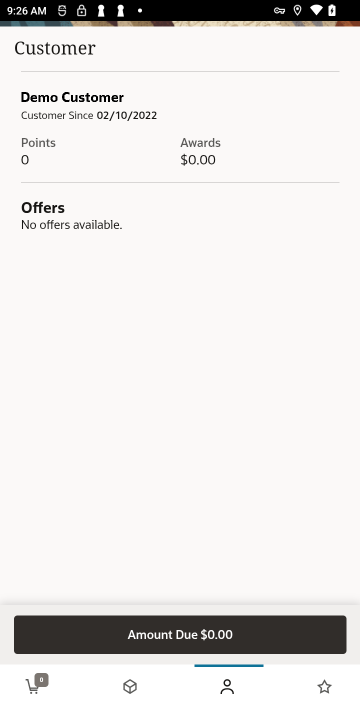
If a transaction is associate with a customer, the Customer Panel may contain the following information based on your configuration:
-
Loyalty Level Badge
-
Customer Name
-
Customer Since
-
Loyalty Points
-
Awards
-
Offers
-
Item Messages
Customer Overview Drawer
Figure 4-5 Customer Overview Drawer
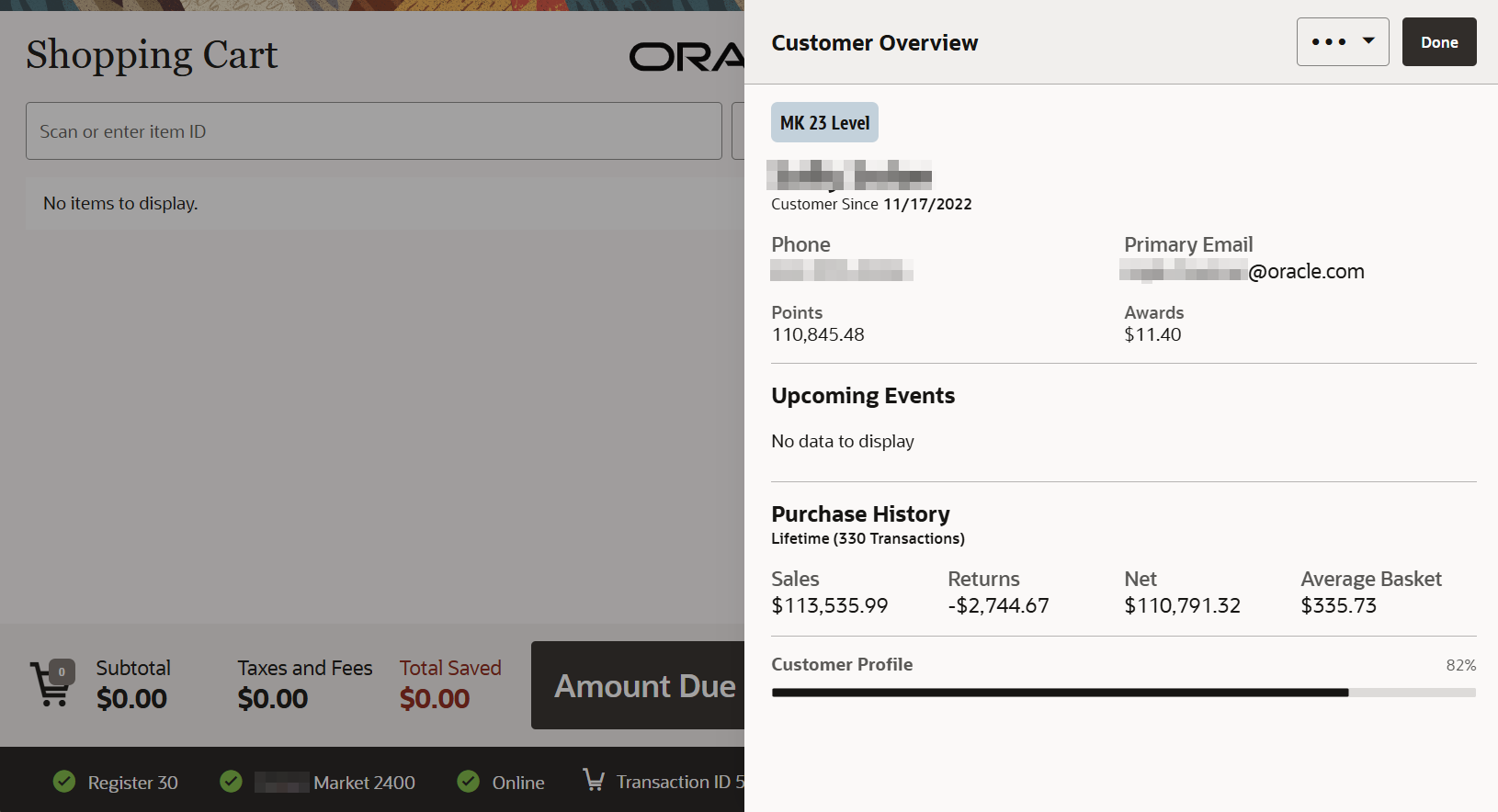
-
Loyalty Level Badge
-
Customer Name
-
Customer Since
-
Phone
-
Primary Email
-
Loyalty Points
-
Awards
-
Upcoming Events
-
Purchasing History
-
Customer Profile
Note:
To display detailed information about the customer, view the Customer Dashboard.Customer Drawer Actions
Figure 4-6 Customer Drawer Actions
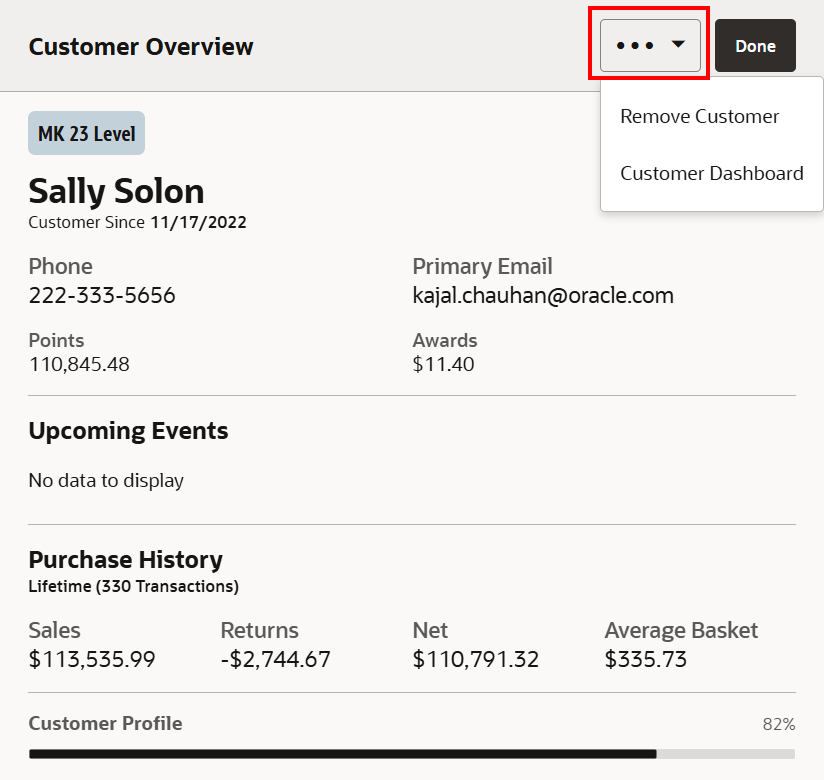
-
Remove Customer - Removes the customer from the current transaction.
-
Customer Dashboard - Displays the Customer Dashboard.
Entering Items
Use the options on the Register Sale menu to enter items, add discounts, modify the transaction, and to add gift registry items. Refer to Adding a Discount to a Transaction or Group of Items, E-mail Receipt Options, Modifying Line Items in a Sale, and Gift Registry for more information about these activities.
You may also be able to enter extended transactions such as:
Note:
To look up an item see Searching for Items.
Adding an Item
To add an item to a transaction from the sale screen:
Figure 4-7 Sale Screen - Scan Item Prompt

Figure 4-8 Empty Cart - Handheld
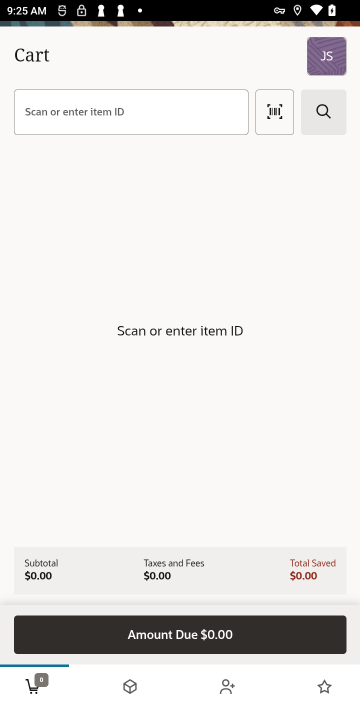
-
Scan an item barcode to add it to the transaction or enter an Item ID manually and select, Enter. Repeat as needed per item. As items are added, Xstore POS automatically applies any promotions and/or discounts that may be relevant to that item. It also shows the unit price, the extended price, and the tax that is relevant on that particular transaction item.
Figure 4-9 Sale Screen - Item Line
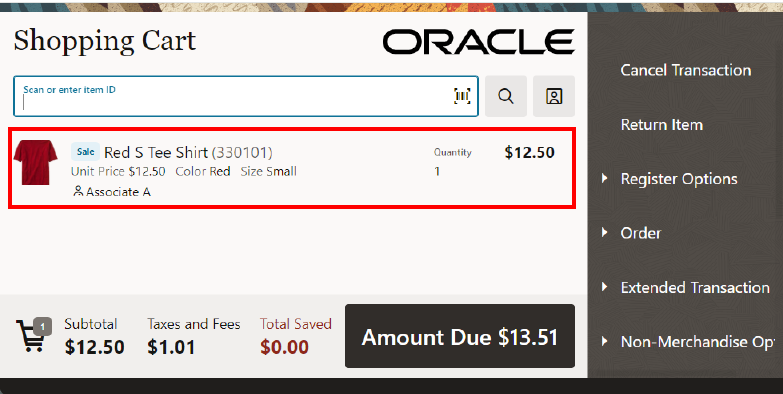
Figure 4-10 Sale Screen - Handheld Item Line
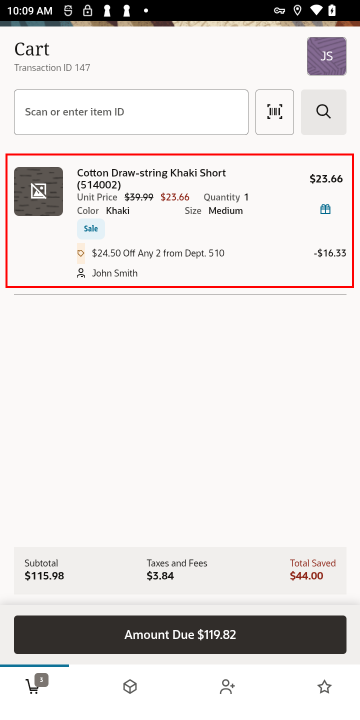
Note:
Selecting the item line within a transaction allows for modifying the item. For detailed information see Modifying Line Items in a Sale.
Quick Items
Use the Quick Items button to view items when configured to be quickly added to the transaction. This option allows you to add frequently purchased items more easily. You can select multiple items if required
Figure 4-11 Desktop Customer Panel - Quick Items

Figure 4-12 Tablet Customer Drawer - Quick Items
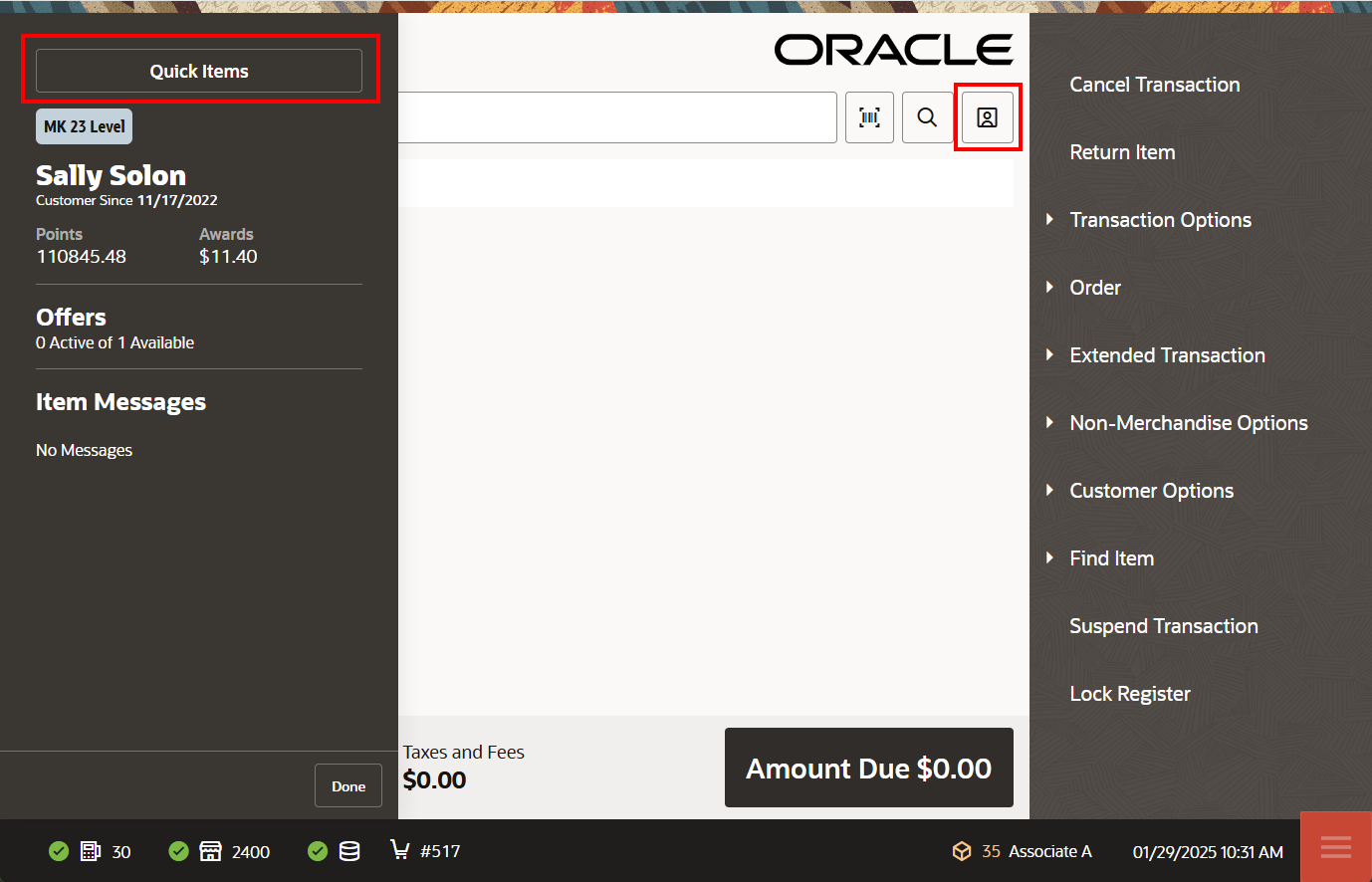
To add an item to the sale transaction by using the Quick Items button, follow the steps below.
-
Select Quick Items. A drawer appears.
Note:
To access Quick Items on a tablet select the Person Icon as shown in the **INTERNAL XREF ERROR** above.Figure 4-13 Quick Items Drawer

Figure 4-14 Quick Items - Handheld
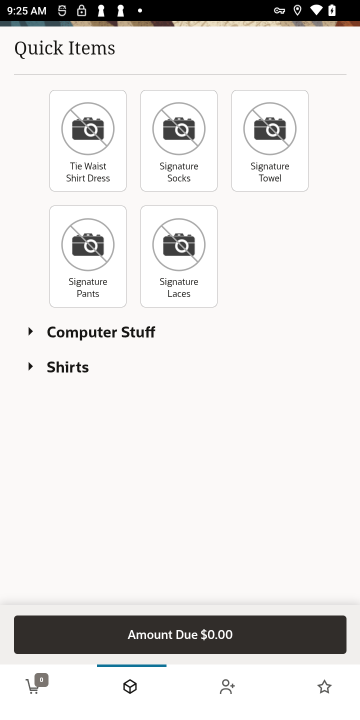
-
Select each item to add to the transaction.
-
The item is displayed on the Sales Display Panel and on the customer display.
-
Click Done to close the Quick Items drawer.
RFID
To support RFID (radio-frequency) scanning, Xstore POS can be integrated to the MagLinQ devices. These devices scan the EPC (Electronic Product Code), which includes scanning and retrieving both the product ID and RFID Reference Tag Number simultaneously.
Scan the RFID tag on the item.
Xstore POS reads the RFID Electronic Product Code (EPC) tag whilst the product barcode provides the product ID, and the RFID tag extracts the unique reference number of the product.
If the scanner is not working, manually enter the product ID.
Adding Non-Merchandise Items to the Sale
Non-merch items such as gift cards, gift card top-up, gift wrapping, cell phone recharge, can be added to the sale.
-
At the Sale screen, select Non-Merchandise Options from the Sale menu to display the list of non-merchandise items available at the store.
Figure 4-15 List of Non-Merchandise Options

Figure 4-16 List of Non-Merchandise Items - Handheld
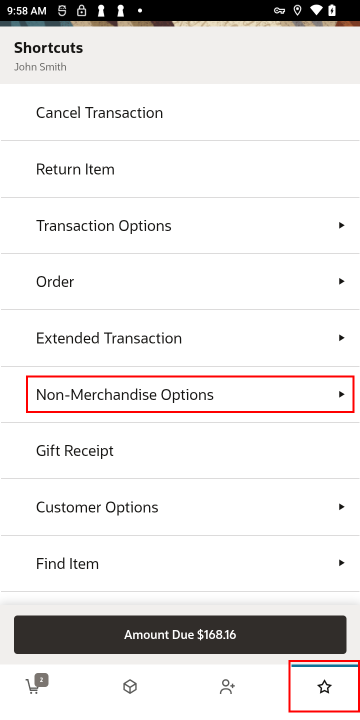
Note:
Because each Xstore POS menu is configurable, the non-merchandise items shown on your system may be different than the options shown in this guide. Depending upon your item choice, you may be prompted for additional information (such as a price).
-
Select an item from the list.
-
If prompted, select a non-merchandise item from the list to add the item to the sale.
Figure 4-17 List of Non-Merchandise Items
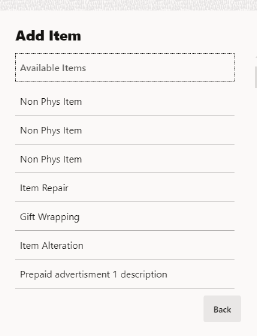
-
Depending upon your item choice, you may be prompted for additional information. If prompted, enter the information as required.
Figure 4-18 Prompt For Price
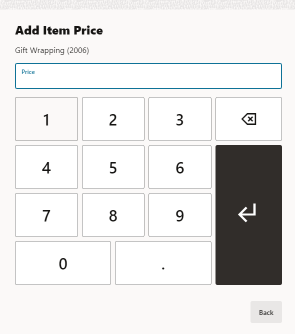
Xstore POS adds the non-merchandise item to the sale and the non-merchandise information is shown.
Item Restrictions
When certain items are selected, restrictions may apply. These include the following:
Customer Age Verification
Age Verification allows you to configure customer age verifications to determine whether a customer meets the age requirements to buy certain items. You can set different age levels for verification (for example, 18 years and 21 years).
An additional age verification is only requested, if an item with a higher restriction is added to the transaction. For example, if the first purchased item has an age limit of 21 and the second item has an age limit of 18, there is only an age verification for the first item, but not for the second one.
To sell an item with an age verification, follow the steps below.
-
Enter an item where an age verification is necessary. Xstore POS Point of Service displays a prompt relating to the date of birth of the customer is before a specified date.
-
Select Yes to confirm the prompt. The item is shown on the Sales Display Panel. For additional items requiring an age verification 18 years, no prompt is displayed.
-
Select No. The item is not added to the Cart. If additional items with an age verification are entered, the prompt is shown again.
-
Cashier Age Restrictions
Xstore POS Point of Service allows you to configure cashier age restrictions to determine whether a cashier has the permission to sell certain items. You can activate/deactivate the cashier age restriction per store.
An additional age verification is only requested if an item with a higher restriction is added to the transaction. For example, if the first purchased item has an age limit of 18, there is only an age verification for the first item, but not for the second one.
If the cashier age restriction is activated and there is no date of birth entered for the cashier, the system displays the cashier age restriction prompt.
-
Enter an item with a cashier age restriction. Xstore POS displays a prompt requesting authorization of the transaction.
Figure 4-19 Cashier Age Restricted Item

-
Select Yes to enter authorized user credentials to the transaction. If No is selected, the item is not added to the sale.
Figure 4-20 Cashier Age Restricted Item Override
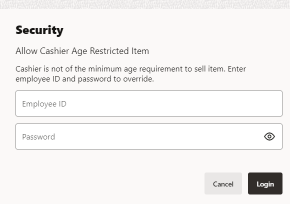
-
Users holding the required security privileges must:
-
Enter their Associate ID.
-
Enter their Password.
-
The item is added to the sales transaction and shown on the Sales Display Panel.
Time Restrictions
Time Restrictions allows you to configure a time frame in which certain items cannot be sold and/or returned, for example, alcohol. If this function is enabled, items with a restricted time frame can only be sold during authorized hours and days. You can activate/deactivate the time frame restriction by item, department and sub-department.
To sell an item with a time restriction, follow the steps below.
-
Enter an item with a restricted time frame.
-
validates the system time and day against the configured restricted time frame.
-
The system displays the prompt, that the item is currently restricted and not available for sale.
-
Select OK to close the prompt.
Other Prompts
-
Style Items
A style is an entry in the item database that has properties such as size, color, and width, and so on. Multiple regular items may be associated with a style ID. If you enter a Style ID, the system prompts for additional information.
Figure 4-21 Style Item
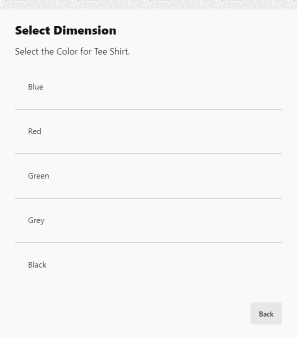
Select the dimension such as the color required.
-
Serial Numbers
If prompted for an item serial number:
Figure 4-22 Serial Number Prompt

Figure 4-23 Redeem Rain Check Prompt - Handheld
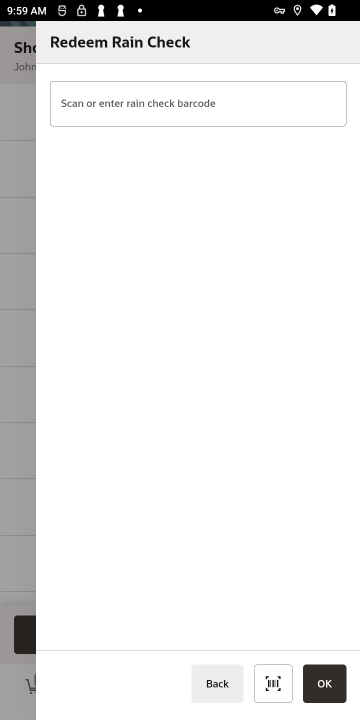
Enter the item serial number and select OK.
To adjust an item, see Adjusting an Item.
When you are finished entering/adjusting items, tender the transaction. See Tendering the Transaction.
Item Actions
To adjust an item that has been added to a transaction:
Figure 4-24 Shopping Cart
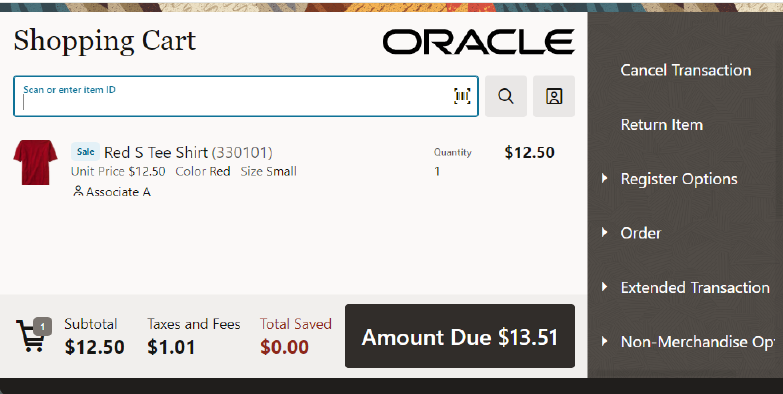
Figure 4-25 Shopping Cart - Handheld
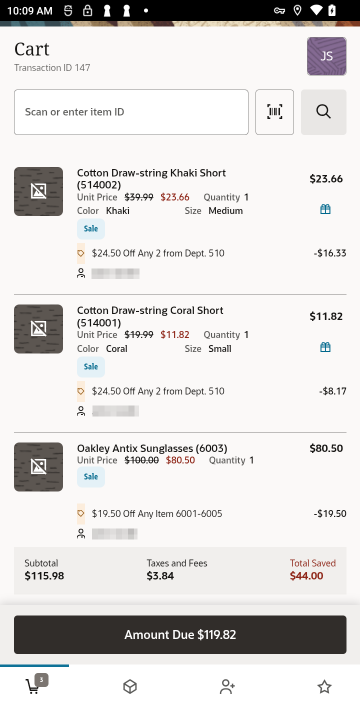
-
Select the item in the item list. The Item Actions Drawer appears.
Figure 4-26 Item Actions Drawer
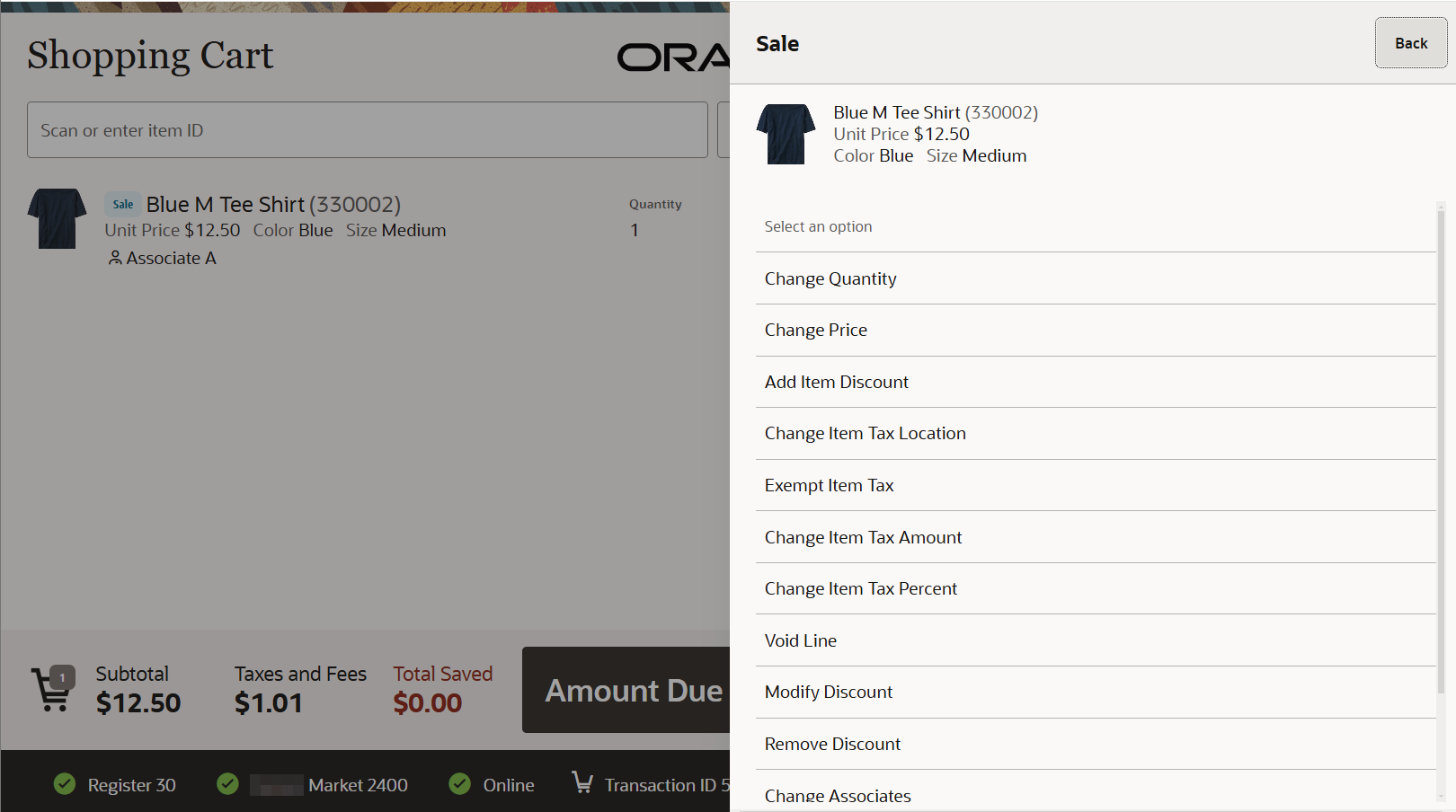
Figure 4-27 Item Actions Drawer – Handheld
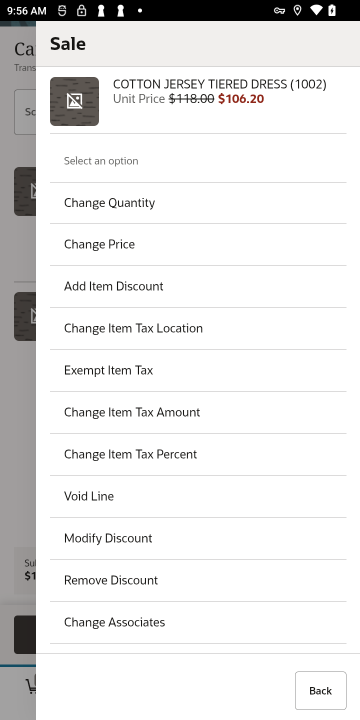
-
Select the change to make to the item.
See Modifying a Transaction for information about the changes that can be made to an item.
To make another item adjustment, repeat these steps.
To add another item to the transaction, see Adding an Item.
When you are finished entering/adjusting items, tender the transaction. See Tendering the Transaction.
Quick Item Swipe Options
Swipe left on an item in the Shopping Cart to display quick item options.
Figure 4-28 Quick Item Options - Swipe Left

-
Remove - Select Remove, then select a Void Line option. The item is removed from the cart.
-
Detail - Select Detail to display the Item Dashboard.
Figure 4-29 Item Dashboard
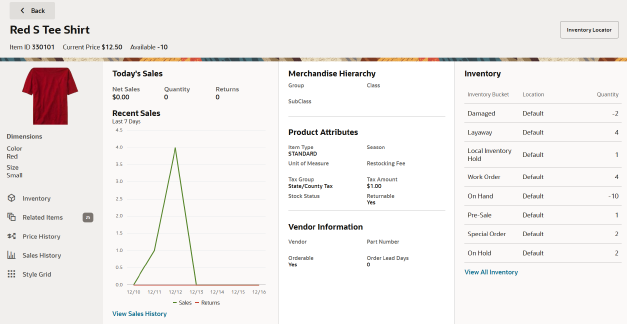
Adding Item Coupons
To add a coupon to a transaction:
Figure 4-30 Register Options

-
Select Register Options in the Context Menu.
Figure 4-31 Add Coupon

-
Select Add Coupon in the Register Options Menu.
Figure 4-32 Coupon ID Prompt
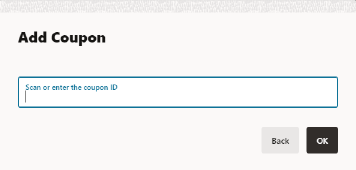
-
Scan the coupon or enter the ID of the coupon.
-
Select OK.
The coupon is applied to the transaction and Xstore POS returns to the item entry screen.
Redeeming a Rain Check
Rain Check is an optional feature that allows customers to purchase out of stock items for the same price later.
To redeem a rain check:
Figure 4-33 Register Options

-
Select Register Options in the Context Menu.
Figure 4-34 Redeem Rain Check
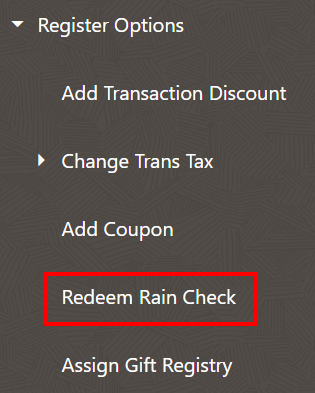
-
Select Redeem Rain Check in the Register Options menu.
Figure 4-35 Redeem Rain Check Prompt
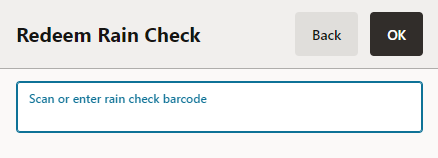
-
Scan the rain check or enter the ID of the rain check.
-
Select OK.
The rain check is applied to the transaction and Xstore POS returns to the item entry screen.
-
If you sell non-merchandise items such as gift cards or services such as gift wrapping, or cell phone recharge, refer to Adding Non-Merchandise Items to the Sale for more information.
-
If you do not know the item number and cannot scan the item, use the Item Lookup option to find the item number. Refer to Searching for Items Using Item Lookup for more information.
-
If the item is not found in the current inventory at this store, use the Inventory Lookup option to locate the item at another location. Refer to Locating Items: Inventory Lookup for more information.
-
To add a discount, refer to Discount an Item for more information.
-
To change the tax (both item and transaction), refer to Changing Item Taxes more information.
-
If your system is configured to support awards and the customer's accumulated rewards can be applied to this transaction, select the Add Discount menu option.
Tendering the Transaction
When the customer is ready to pay for the transaction, select Amount Due to display the Payment Options (Tendering).
Figure 4-36 Amount Due
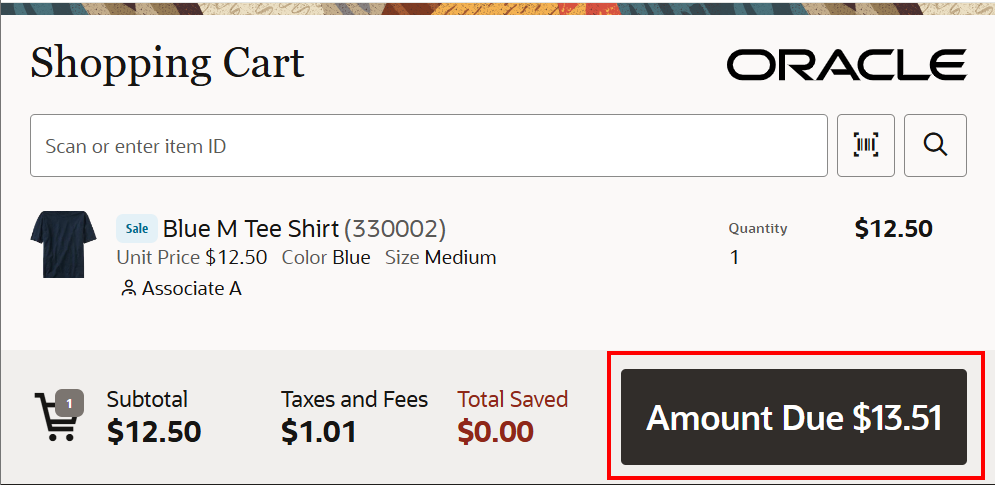
Figure 4-37 Amount Due - Handheld
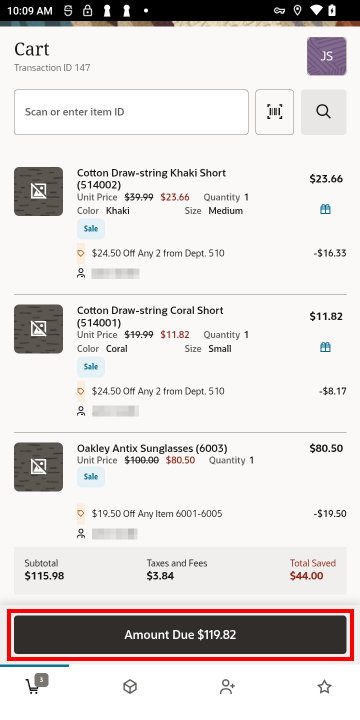
Figure 4-38 Payment Options
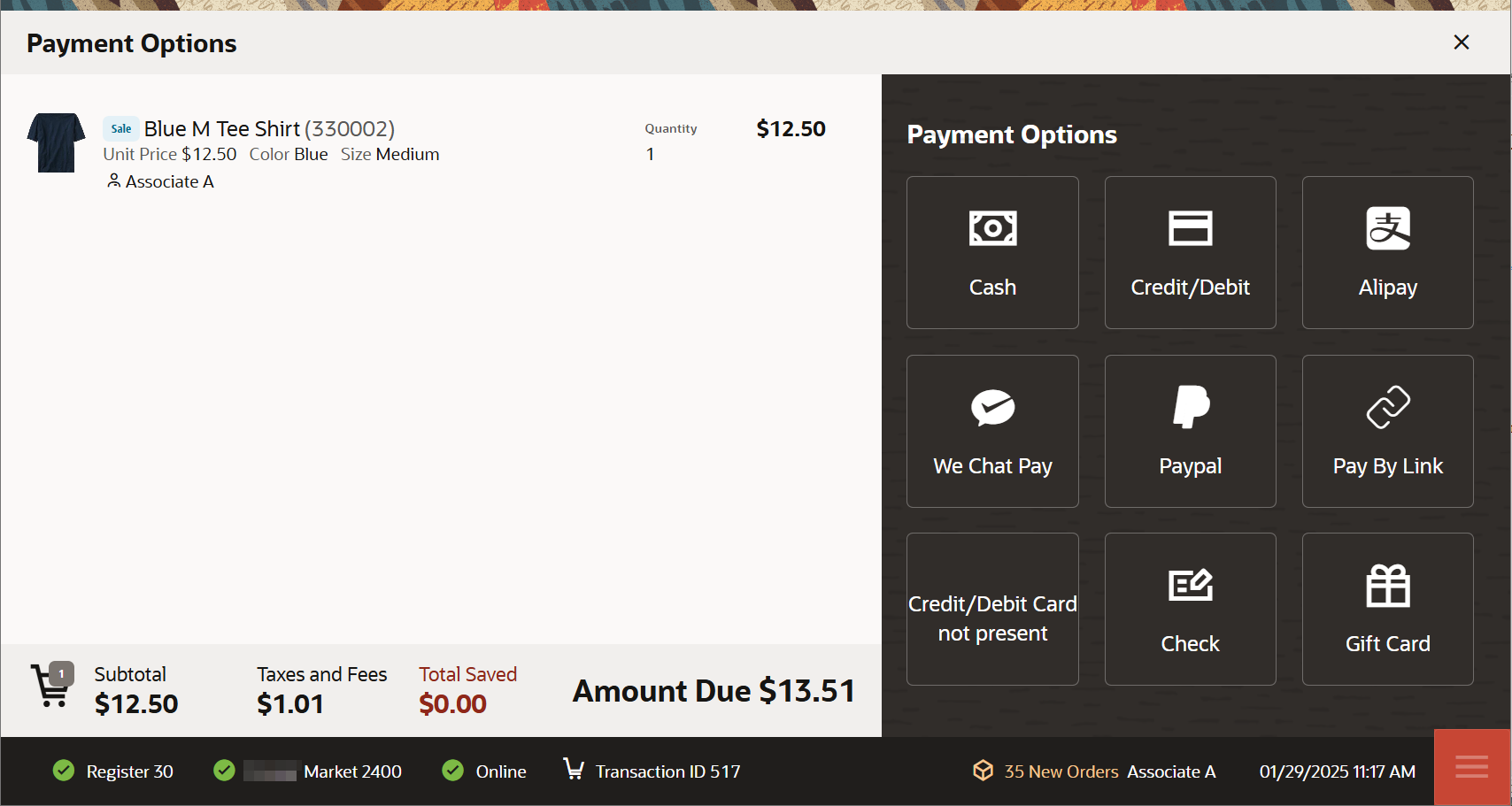
Figure 4-39 Payment Options - Tenders (Cart Collapsed)

Figure 4-40 Payment Options - Tenders (Cart Expanded)

The tendering process requires that you select or enter two basic items of information:
-
Form of payment (also called tender type-cash, check, credit card, gift card, foreign currency, and so on)
-
Amount paid with that tender type
Depending upon the form of payment and your store's policies, you may have to enter or select additional information, for example:
-
Credit card account number, CID number, and expiration date
-
Additional tender types if the first tender type did not pay the total due
-
Additional forms of customer ID (driver's license number, birth date, credit card number, or other ID)
-
Customer name
-
Customer address
-
Security approval for large sales or refunds
Refer to Processing Tenders for additional information about specific tenders.
Completing the Transaction
During this process the system may be configured to perform the End of Transaction Calculation. A notification will appear stating “Deal Calculation in Process”. The prompt will close when the calculation is completed. This process can be configured to run as each item is added to the transaction or after Amount Due is selected.
-
When you are ready to complete the transaction, you can select Amount Due at the bottom of the screen. You can also swipe a credit card in a MSR or in a signature capture device.
An example configuration of this process is a prompt to round up the amount for a charitable donation. Round up for Charity is a configuration option to allow the customer to support a charity determined by the retailer. When configured the following steps apply:
-
Select No to continue with tendering without adding the amount.
-
Select Yes to add the charitable donation to the transaction, then continue with tendering.
The available tender types are shown.
Note:
The tender types will vary based on your configuration. -
-
At the tender list, select the tender type.
Figure 4-41 Tender Types

-
At the tender amount prompt, enter the amount of the tender. Depending upon the tender type you selected, the tender amount prompt may default to the total amount due for the sale transaction.
Figure 4-42 Tender Cash Amount Prompt
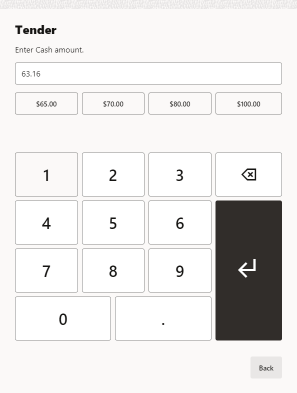
Figure 4-43 Tender Cash Amount Prompt - Handheld
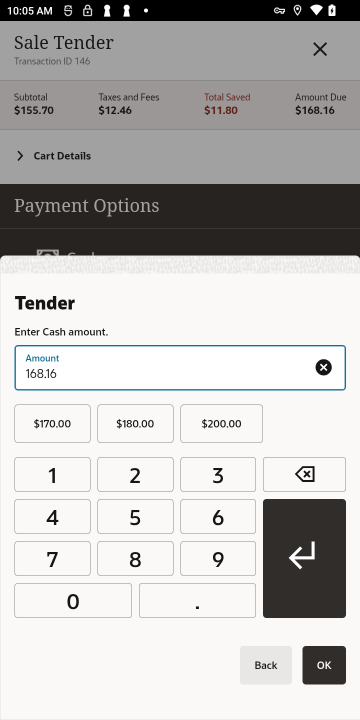
Note:
Split Tenders: You may enter a partial amount if the purchase is paid with more than one tender type. After selecting a tender type, entering the amount and selecting OK, the system automatically prompts for the remaining balance due and you may select any of the valid tender types. See Splitting Tenders for more information.
<OR>
Select one of the Quick Cash buttons.
Figure 4-44 Quick Cash Buttons
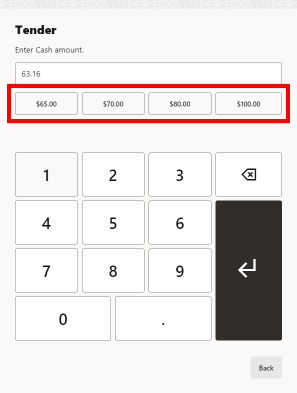
-
Selecting a tender line brings up the Modify Tender menu where in rare occurrences, you can choose to void a tender, or to change a tender amount.
Figure 4-45 Modify Tender Menu

Note:
Your system may print receipts without prompting you to confirm that the sale is complete. In that case, the system prints receipts as soon as the total of all tenders selected equals or exceeds the amount due.
If prompted, select to complete the transaction.
-
The system prints receipts as required. If you are utilizing shared printers, select a specific printer.
Note:
If your store issues e-mail receipts, additional/different prompts display. Refer to E-mail Receipt Options for more information about sending e-mail receipts.
Note:
See Printing a Gift Receipt for information about printing Gift Receipts.
-
Depending upon the configuration of your system, you may be prompted to scan a cash drawer. Scan the appropriate cash drawer for your system.
Note:
Note: If you are prompted that the cash drawer is unavailable, either wait for the cash drawer to become available, or scan a different cash drawer.
-
If required, provide change to the customer and close the cash drawer to complete the transaction.
Figure 4-46 Cash Drawer Change
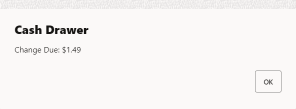
-
On occasion, upon completing a transaction, a prompt may open asking whether to apply a system update.
Note:
If you agree to perform the system update, you will not be able to create any new transactions for a certain grace period. Existing transactions can be completed during the grace period.
Once the system is not in a transaction or if the required period has expired, the update will be automatically applied without asking the user. You cannot use the system during system updates.
-
Select No to be asked again after a period.
-
Select Yes to apply the update. A confirmation prompt opens:
-
Select Apply to perform the update.
-
Select Cancel to cancel the update and be asked to perform the update after a period.
-
-
Vertex Tax Engine
Overview
The optional integration of the Vertex Tax Engine with the Oracle Retail Xstore Point of Service system plays a crucial role in automating tax processes and significantly improving tax accuracy for businesses. With this, Xstore enables a more streamlined and efficient tax management experience.
Xstore facilitates the integration with the Vertex Tax Engine through two distinct methods:
-
Containerized Implementation: Businesses have the option to implement the Vertex Tax Engine as a containerized solution within the Xstore ecosystem. This means that the tax engine is encapsulated within a container, ensuring a standardized and isolated environment for tax calculations. This approach offers flexibility and scalability, allowing businesses to adapt the tax engine to their specific requirements.
-
Vertex Cloud Services Integration: Alternatively, Xstore also provides integration with the Vertex Cloud Services, which are directly offered by the Vertex Tax Engine. This approach allows businesses to leverage the cloud-based capabilities of the Vertex Tax Engine without the need to manage and maintain the tax engine infrastructure on-premises.
By providing these integration options and authentication methods, Xstore empowers businesses to optimize their tax processes, ensuring accuracy, compliance, and seamless handling of tax-related operations, whether through containerized implementation or cloud-based services offered by the Vertex Tax Engine.
Email Receipt Options
Email receipts (e-receipts) save paper and time.
If your store issues email receipts, you may be prompted for more information after the sale is tendered. Any receipts that have been set up for email delivery are generated as PDF documents and sent to the customer's email address as an email attachment. This email receipt process assumes the customer has an active email address and has given permission to receive email from the store.
-
After tendering the sale or return, you are prompted to select a receipt method, unless the customer has been set up to automatically receive email receipts, in which case go directly to the next step.
Figure 4-47 Receipt Options
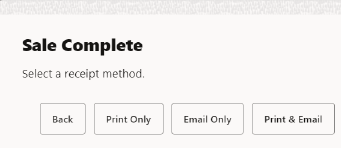
Figure 4-48 Receipt Options - Handheld
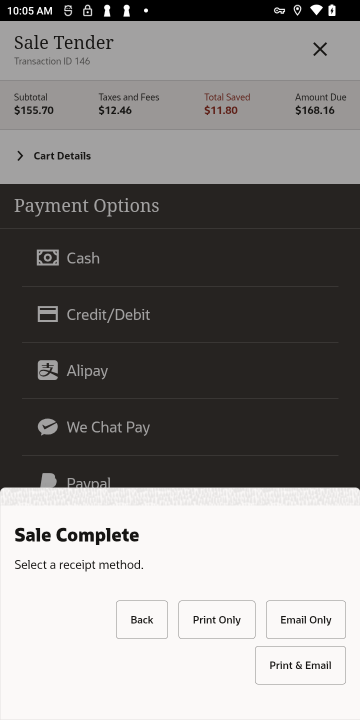
Note:
The choice you make here applies to all receipts. For example, if you choose to email receipts, then all receipts such as Gift and Customer receipts are sent in an email. You cannot print one but email the other.
However, any receipt types that are not supported for distribution in an email, per your store policy, automatically print on the receipt printer.
-
To print the receipt(s), select Print Only. All receipts are printed on the receipt printer and the transaction is complete.
-
To email the receipt(s) to the customer, select Email Only or Print & Email and continue with step 2 below.
-
-
If you chose to email the receipt(s), you are prompted for the customer's email address:
-
If no customer is associated with the sale, enter the customer's email address.
-
If a customer with an email address on file is associated with the sale, verify the customer's email address is correct as shown on the prompt. You can change the address if needed.
-
-
Select a receipt option:
Figure 4-49 Email Address Prompt
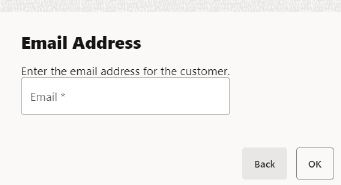
-
If you decide not to send an email receipt, select Back to return to the Sale Complete prompt.
Note:
The customer may have indicated that they wish to have email receipts as their default. If this is the case, you will not be prompted for the customer's email address.
Email addresses are validated for proper format. If the email address does not have proper formatting, a warning message displays. Select Enter to acknowledge the message and return to the Email Address prompt where you can correct the error.
If you make any changes to a customer's email address on file, you may be prompted whether the customer's profile should be updated with this new email address:
-
Select No to send the receipt to the new address but keep the old address on file.
-
Select Yes to send the receipt to the new address and to also update the customer's profile with the new email address.
If there are multiple receipts on the transaction, they are sent as multiple PDFs in one email.
-
-
Receipts
This section describes the Receipt functions.
Multiple Printers
Stores that have multiple receipt printers can select a printer from a list of available printers or scan a QR Code and the receipt prints to that selected printer. If only one printer is available, the receipt prints directly to that printer and no selection is required.
Figure 4-50 Multiple Printer List

QR Code
In addition to selecting a printer from a list, you can scan a QR code placed on the front of an IP enabled receipt printer to select that printer.
-
Select Print or Print and Email receipt method to print a receipt.
-
From the list of printers displayed, select the barcode icon (shown on the top left of the Printer Selection list) to open the device camera.
-
Scan the QR code on the front of the printer.
When a QR code is valid and the receipt printer is configured, Xstore will send the data to the scanned printer. The printer list closes automatically.
When the QR code does not contain the information expected an 'Invalid Scan' message is shown.
When a QR code is scanned and Xstore finds it has valid information but is not part of the available printers, the message 'Receipt printer is not configured' is shown.
Note:
Retailers are responsible for creating QR codes for printers and placing them on the appropriate printers. They are also responsible for configuring available printers.
Printing a Gift Receipt
During a transaction, items may be selected for a gift receipt before a tender is selected, or between adding tenders. Gift receipts can also be issued immediately after a completed sale transaction, or from the Electronic Journal for eligible items in a transaction. Eligible items include regular sale items, special order pickup items, and layaway pickup items.
Gift Receipt Items in a Sale
While a sale transaction is being performed, you may use the following steps to select items to be issued gift receipts:
Figure 4-51 Gift Receipt Option
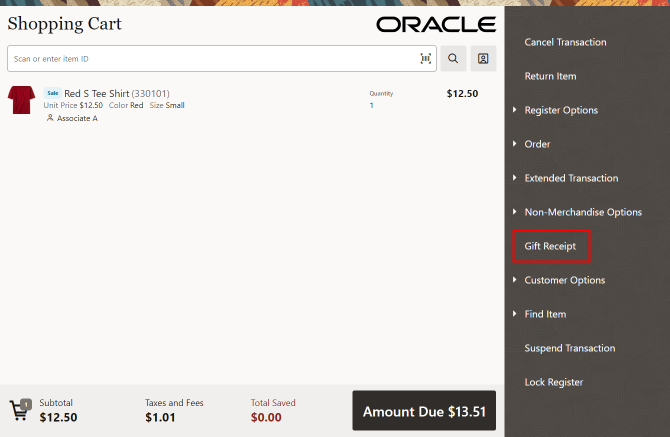
-
During a sale transaction, select Gift Receipt in the Sales Transaction Menu. Xstore POS displays a list of items eligible for gift receipts.
Figure 4-52 Gift Receipt Items
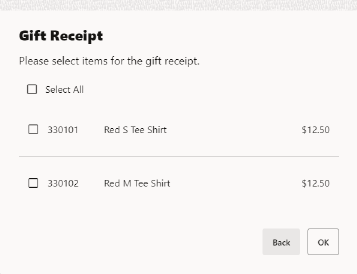
Figure 4-53 Gift Receipt Items - Handheld
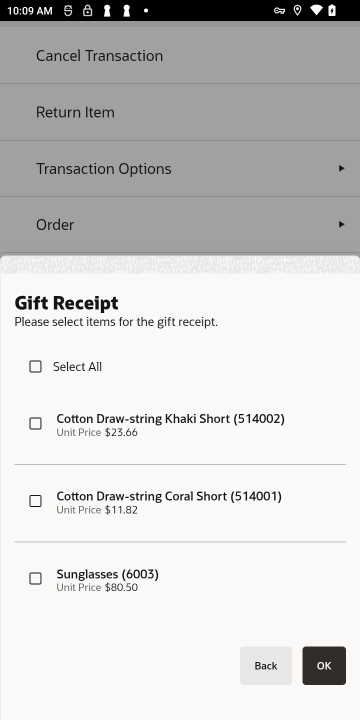
-
Select Select All to print gift receipts for all items and select OK.
<OR>
Select the gift receipt items for which to print a gift receipt and select OK.
-
Click OK.
The gift receipt items are labeled in the View Port with a gift icon. Gift receipts will be printed at the end of the transaction.
-
At the end of the transaction, if you are prompted whether to group gift receipt items, see Group Gift Receipt Items.
-
At the end of the transaction, you may be prompted whether to print a gift receipt for each item:
Figure 4-54 Multiple Gift Receipt Prompt
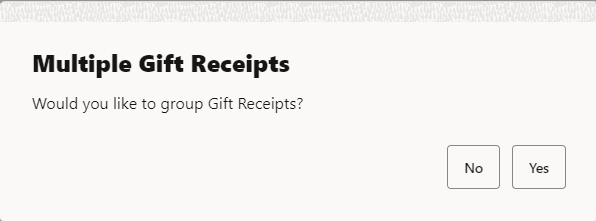
-
Click No to print a gift receipt for each item. See Group Gift Receipt Items for more details.
-
Click Yes to print one gift receipt for all items.
-
Group Gift Receipt Items
After tendering the sale, if there are multiple items that have been labeled as requiring a gift receipt, you may be prompted whether to group items on separate gift receipts. For example, you can group 2 items on one receipt, and 3 items on another receipt.
To group items on gift receipts:
Figure 4-55 Group Gift Receipts Prompt
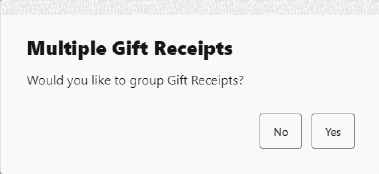
-
If you are prompted whether to group gift receipts, select an option:
-
Click Yes to group gift receipt items. A gift receipt grouping window opens.
-
Click No to continue the transaction without creating gift receipt groups.
-
-
Select the items to group on one gift receipt.
-
Click Add Grouping.
The selected items are grouped into one gift receipt and removed from the list.
-
Repeat Steps 2 to 3 for each gift receipt group.
-
Click Finish and Print to print the gift receipts and complete the transaction.
Reprint Receipts and Documents
The reprint options provide a way to recover when there is a printer error or the printer jams. They allow you to reprint a receipt or a rebate offer for the customer.
-
Navigate to the Home Screen Menu.
Figure 4-56 Home Screen Menu
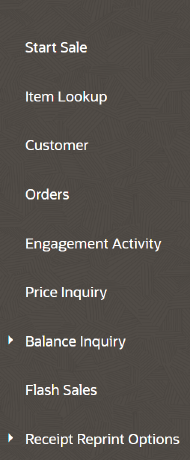
-
Select Receipt Reprint Options from the Home Screen Menu.
Figure 4-57 Receipt Reprint Options
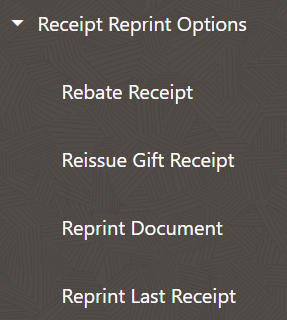
The following options are available:
Print a Rebate Receipt
Rebate receipts may be offered to customers so that they can retain the original receipt for a purchase, and mail in the rebate receipt as proof of purchase.
-
Select Rebate Receipt (See Figure 4-57). The system prompts for transaction information.
Figure 4-58 Transaction Lookup
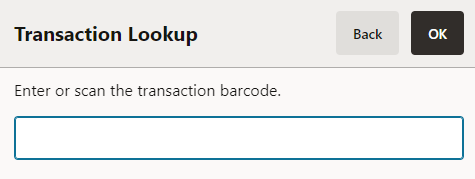
-
Enter the transaction information by doing one of the following:
-
Scan the barcode on the original sale receipt.
-
Enter the barcode information and select Enter. The rebate receipt prints on the receipt printer.
Note:
The receipt is clearly labeled as a rebate authorization receipt.
-
This receipt cannot be used for merchandise returns.
Reissue a Gift Receipt
To create gift receipts for a previously completed transaction:
-
Select Reissue Gift Receipt (See Figure 4-57). The system prompts for transaction information.
Figure 4-59 Transaction Lookup

-
Enter the transaction information by doing one of the following:
-
Scan the barcode on the original transaction receipt.
-
Enter the barcode information and select Enter.
Xstore POS displays a list of items eligible for a gift receipt.
-
-
Select the gift receipt items using the appropriate procedure:
Xstore POS prints the receipt.
Reprint a Document
To reprint a document (such as a rebate offer):
-
Click Receipt Document. (See Figure 4-57).
The Reprint Document Lookup window opens.
Figure 4-60 Reprint Document Lookup
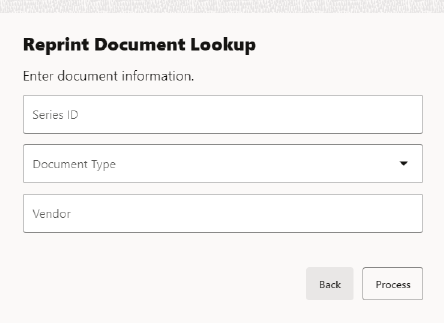
Figure 4-61 Reprint Document Lookup - Handheld
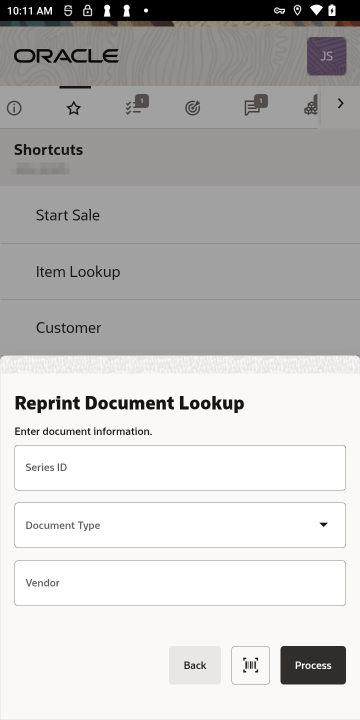
-
Enter the search information for the document:
-
Series ID: Enter the ID for the document series.
-
Document Type: Select the type of document.
-
Vendor: Enter the name of the vendor who produced the document.
-
-
Click Process.
Xstore POS displays a list of documents matching the search criteria.
-
Click the correct document.
-
Select Reprint Selected or Reprint All.
Xstore POS reprints the document on the report printer.
Reprint the Last Receipt
To reprint the last receipt created by the register:
-
Click Reprint Last Receipt (See Figure 4-57).
Xstore POS prompts whether to reprint the last receipt.
-
Click Yes to reprint the last receipt.
Note:
The receipt is clearly labeled as a reprinted receipt.
Offline Sales Transactions
If connection to all mobile servers is lost, it is possible to enter in basic sales and return transactions manually in Xstore POS, if your system is configured to do so.
-
Select Change Server from the Connectivity Problem screen.
-
Select Offline POS from the Change Server screen.
See Offline Transactions for more information.
Entering an Offline Transaction
Select New Transaction from the Offline POS screen.
Two options are available:
-
Add Item - goes to the manual sales transaction entry screen.
-
Add Return - goes to the manual return screen to prompt for receipt data. See Entering Returns when in Offline Mode for more information on return transactions.
Perform a Sales Transaction
To perform a sale in offline mode:
-
Select Add Item.
-
Scan an item barcode to add it to the transaction or enter an Item ID manually.
-
Change item price if needed.
-
Optionally, add a comment for the sale item.
-
Select OK.
-
Repeat the steps above as needed to add each item.
-
When done, select Add Tender.
-
Select a tender type from the dropdown list. Not all tender types are available.
Optionally, add a comment for the tender.
-
Select OK when done.
-
Select Complete Transaction and enter an email address for the receipt.
Optionally, enter a comment.
-
Select Show Receipt.
-
Select OK. The UUID QR code is printed.
Ask the customer to take a picture of the code with their mobile phone or to write down the receipt code.
This UUID QR code can be used for returning the items or to get a transaction receipt when the store is back online. See Printing a Transaction Receipt for more information.
At the end of each transaction the system checks to determine if the mobile server is back online:
-
If the mobile server the device was configured to use is back online, then the device returns to the Xstore POS login screen.
-
If another server in the list is online, you are taken to the Change Server configuration screen. The offline mode will then be disabled. See Offline Transactions for more information.
-
If no servers are available, you go to the list of offline transactions and can choose to conduct another one or return to the Change Server screen.
See Reviewing Offline Transactions when the mobile server is back online to approve or reject the transactions performed whilst offline.
Note:
All offline transactions need approving/rejecting before store close.